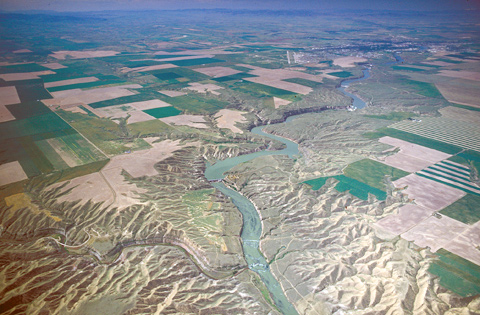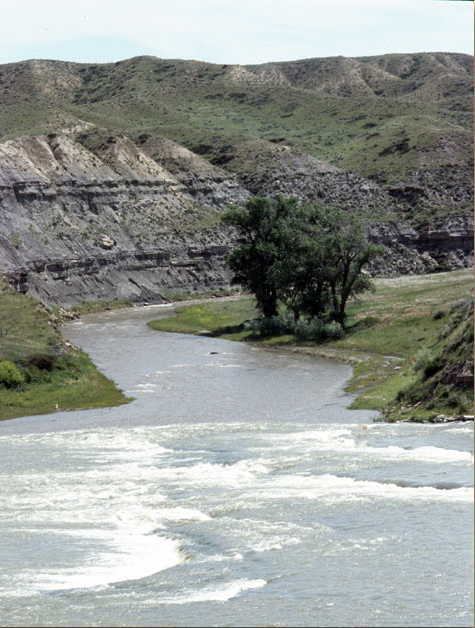By the evening of 15 June 1805, Clark had gotten the canoes and the white perogue as close to the Great Falls as possible, and the next afternoon Lewis joined him at the “lower portage camp,” a mile below the mouth of Portage Creek (now Belt Creek), at bottom center of this photograph. Just above the creek is Morony Dam, completed in 1930; there is no natural waterfall there. Next upstream is Ryan Dam, completed in 1915, at the “Grand Fall.”
The good news was that the captains had chosen the correct fork back at the Missouri’s confusing confluence with the Marias River. The bad news was that the shortest way around the falls, on the south side, would be at least fifteen miles long, Lewis thought. Worse yet was the fact that Sacagawea was gravely ill. On the 16th Lewis sent a detail to the sulfur spring [Sulphur Springs] opposite the mouth of Portage Creek for some of the supposedly medicinal water. She recovered quickly, and by the 20th was up and about–even fishing.
On 17 June 1805, Lewis had the white pirogue unloaded and stored on the north side of the river opposite their camp. Four days later the men began wrestling their six dugout canoes up Portage Creek as far as the pictured road crossing, placing them on improvised wooden trucks, and dragging them up onto the level prairie. Their eighteen-mile route crossed the deep coulee at left of center, cut westward through today’s Malmstrom Air Force Base, and turned southwest to the upper portage camp, on the riverbank opposite White Bear Islands (no longer in existence), beyond the view in the photo. The portage was completed on 2 July 1805 after four trips that were occasionally delayed by rain, hail, and mud.
we found much difficulty in getting the canoes up this creek to the distance we were compelled to take them, in consequence of the rappids and rocks which obstruct the channel of the creek. one of the canoes overset and was very near injuring 2 men essencially. just above the canoes the creek has a perpendicular fall of 5 feet and the cliffts again become very steep and high.
—Meriwether Lewis, 17 June 1805
On the voyage home in July 1806, Sergeants Ordway and Gass and fourteen enlisted men, with the benefit of four horses to pull their two crude wagons loaded with dugout canoes, completed the downstream portage in just five days.
From Discovering Lewis & Clark from the Air
Photography by Jim Wark
Text by Joseph Mussulman
Reproduced by permission of Mountain Press
Experience the Lewis and Clark Trail
The Lewis and Clark Trail Experience—our sister site at lewisandclark.travel—connects the world to people and places on the Lewis and Clark Trail.
Plan a trip related to Lower Portage Camp:

The Great Falls Lower Portage is a High Potential Historic Site along the Lewis and Clark National Historic Trail managed by the U.S. National Park Service. It includes Sulphur Springs (open to the public) and Lower Portage camp site (private land).—ed.




